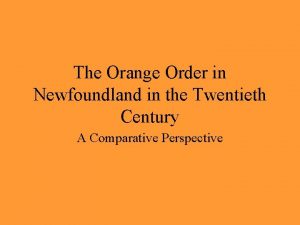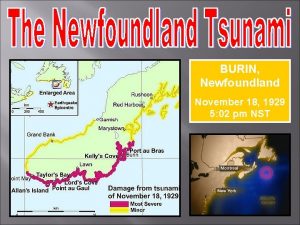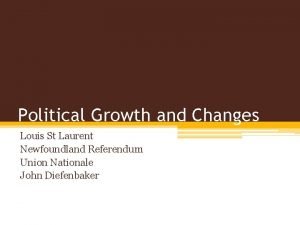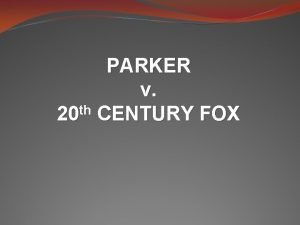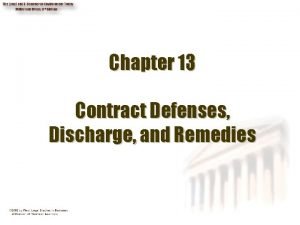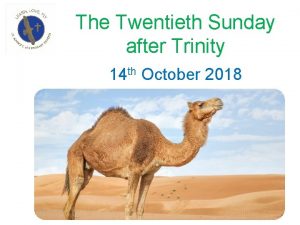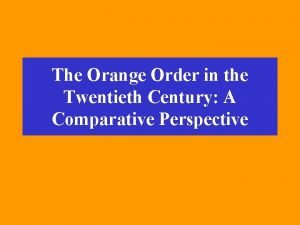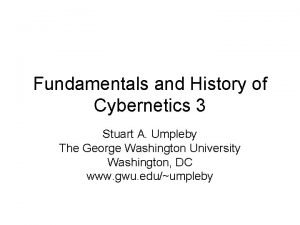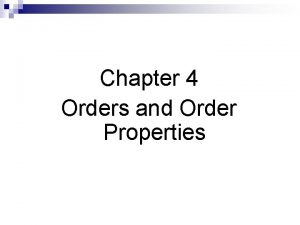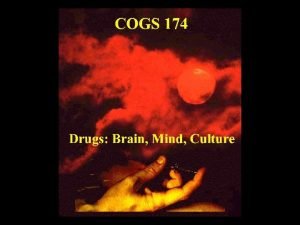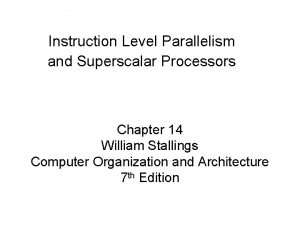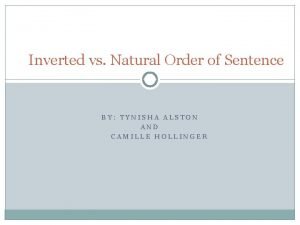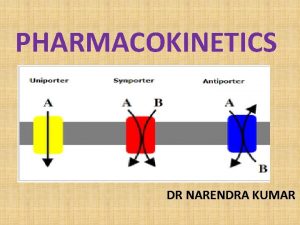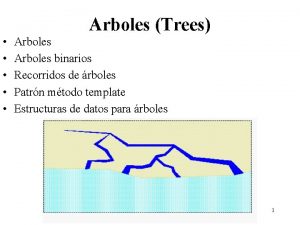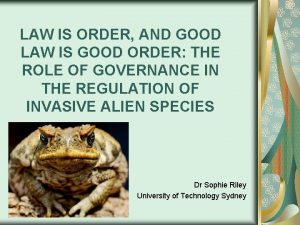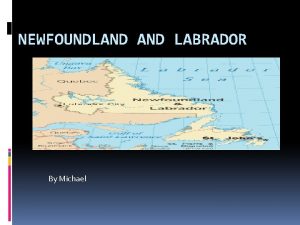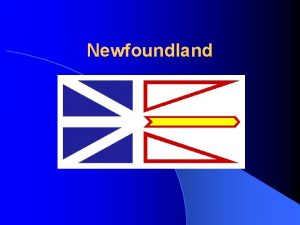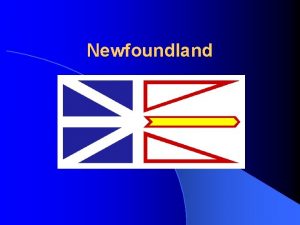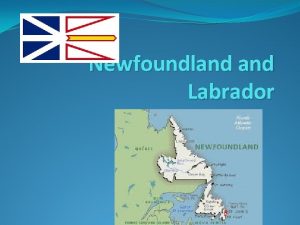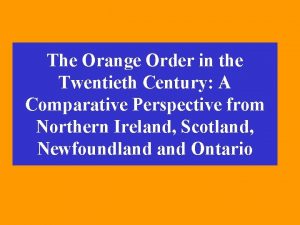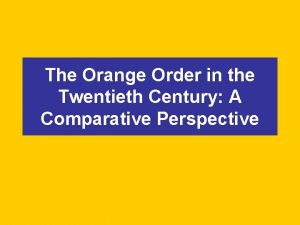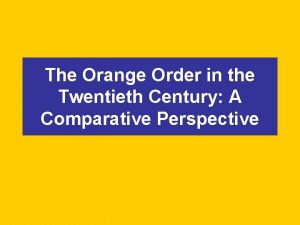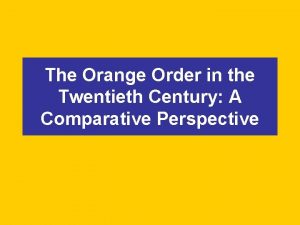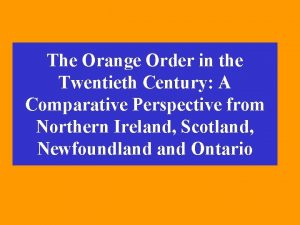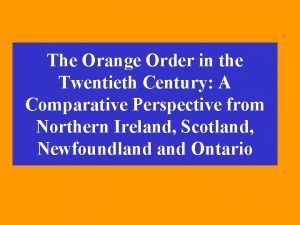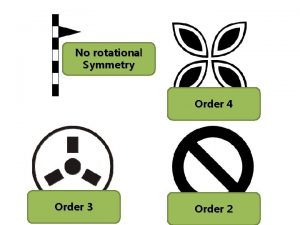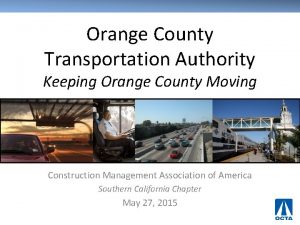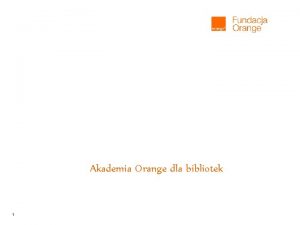The Orange Order in Newfoundland in the Twentieth




















































- Slides: 52

The Orange Order in Newfoundland in the Twentieth Century A Comparative Perspective


Lord Nelson Loyal Orange Lodge #149 in Woody Point, Bonne Bay, St. Barbe

The Orange Order • Formed 1795 in Northern Ireland • Stands for loyalty to British Crown & Protestantism • Rapid spread internationally • Associative cornerstone of British dominant ethnic groups in Canada, N. I. , west-central Scotland

Research Strategy • Based on Previously Restricted Membership Data • Previous research has only tracked the number of lodges • Membership data highlights different patterns, contrasts with census and electoral data • I will look at patterns of membership over time and place • Also qualitative data from lodge rolls and internal Orange reports of proceedings and minute books



International Orange Strength • Newfoundland the strongest Orange jurisdiction, similar to Ulster border counties • Belfast area and Ontario similar • WC Scotland NW England much weaker




20 th c. International Orange Membership Trends • Explosive growth in the 1900 -1920 period in all locales, especially Ontario and Newfoundland • Ontario declines first, 1920 • Newfoundland Northern Ireland decline after 1960, though faster in NF • Scotland declines from 1982, but from smaller base

Newfoundland Orange Lodges (adjusted by size), 1908

Orange Lodges (adjusted by size) Newfoundland, 1908 & 1961







Explaining Orange Strength • Does the presence of Catholics stimulate membership? • How important are Irish-Protestant immigrants? • Is Orangeism associated with the Anglican (established) Church as opposed to Salvation Army/Pentecostals? • Is Orangeism associated with rural areas?

Male Orange Density, N. I. , 1971

N. I. Counties, by Protestant Percentage, 1971

Church of Ireland Protestants, N. I. Counties, 1971

Roman Catholic Percentage, Scottish Counties, 1961

Male Orange Lodges, Southern Ontario, c. 1975




Orange Order Density 1991




Explaining Orange Strength • Does the presence of Catholics stimulate membership? NO • Are Irish-Protestant immigrants important? NO • Is Orangeism associated with the Anglican (established) Church as opposed to Salvation Army/Pentecostals? NO • Is Orangeism associated with rural areas? YES?

Lodge Decline: LOL# 127, Port Leamington, Green Bay • Membership decline: from 44 members 1908, 47 members in 1943, 18 in 1971, defunct thereafter • Average in 1971: 59 • 8 pensioners of 15 members in 1971

Orange Membership Decline: Francois LOL #207, 1929 -78 • 1929: average of 25, membership 70, nearly all fishermen (95%) • 1952: average of 36, membership 43, nearly all fishermen (95%) • 1978: average of 40, membership 20, 65% fishermen, 10% retired, 25% bourgeois and government



Masonic Initiates, St. John's, Newfoundland • 1912 -18. Average age: 44 – – – – – Medical Doctor Manufacturer Merchant Jeweller Dentist Hardware dealer Journalist Manufacturing manager Merchant Acting judge Merchant Jeweller Accountant Merchant Manager Clerk Manager Tailor Draper • 1992 Initiates. Average age: 43. 5 – – – – – Investment officer Police officer Company president Semi-retired Manager Insurance adjuster Investigator Business owner Insurance sales Transport canada Nfld hydro Retired Paramedic Car sales Teacher

Orange vs. Masonic Occupations • Francois LOL# 207 (Burgeo& Lapoile), Members, 1928 -29 – Average age: 24. 6 – Occupations: • 66 Fishermen • 2 Teachers • 2 Clerks • Fortune (Bay), Masonic Lodge, Initiates, 1921 – Average age: 30. 7 – Occupations: • • 1 seaman 1 master mariner 4 clerks 1 clergyman 1 bank manager 4 Fishermen 1 Farmer


Social & Political Influence. Canada • • • Politically influential by 1867 Many Tory MPs were members Involved in most national issues 1/3 of Ontario legislature was Orange in 1915 1/3 of Ontario males were members during 1870 -1920 • Hundreds of thousands in the wider Orange fraternity as late as the 1950's

Political Influence in N. Ireland • Helped found Ulster Unionist Party • Guaranteed 15% of seats on Ulster Unionist Council • Virtually all Official Unionist MPs are, and have been, Orange members • Orange Order an influential lobby

Social & Political Influence. Newfoundland • Many Newfoundland Prime Ministers, Premiers and Statesmen were members (Squires, Coaker, Smallwood, etc) • 50% of Protestant members of House of Assembly in 1885 were Orangemen (Senior 1959) • Roughly 20% of the Newfoundland social register were Orangemen, 1927 -37


An Order Divided? • How much did the 'Orange vote' count? • January, 1895 debate in Brigus LOL# 59, Conception Bay: – Royal Commission/Crown Colony vs. Confederation – 8 speakers spoke for either side. 'Decision was reached in favour of Royal Commission/ Crown Colony' • Divisions also evident over 1948 Confederation Debate

The 'Orange Letter' Incident • 1948 'Orange Letter' warns of Catholic conspiracy, driven by Catholic paper, 'The Monitor' • Resolution was first proposed by men's and women's lodges in Little Catalina: – 'We. . have come to the conclusion that the Roman Catholic Church is endeavouring to dominate Newfoundland. We have reached this conclusion after careful consideration of the results of votes from the various RC settlements during the National Referendum' (1948 report of proceedings)

LOL # 26, Cupids (Conception Bay), 1949 • 1948: 'Bro Butler gave a very interesting address on Confederation with Canada and stated his reasons why he was not in favour [of] Newfoundland joining up with Canada. It was moved and seconded that this lodge tender Bro. Butler a vote of thanks for his able address' • 1949: 'Whereas there was a resolution passed by the Provincial Grand Lodge in session at Grand Falls in July 1948 relative to the attitude of the RC Church towards the Referendum … the funds of the PG lodge were used for printing these unnecessary copies. ' • 'We demand an investigation into those who distributed this letter to the general public when it was intended only for Orangemen' • 'We protest against use of Grand Lodge funds for printing unnecessary circulars'


Moderate Orangeism? • Few 20 th c references to distribution of government posts or spending, Catholic conspiracies, or major national issues (contrast with other provinces and Britain/Ireland) • Joey Smallwood supports initiatives like Brotherhood Week and Royal Bi & Bi Commission • As Grand Master of Canada in the mid-1960 s, George Warren urges an open attitude to immigration and a change in the traditional Orange attitude of being 'agin everything' • Newfoundland Order pushes for annulment of intermarriage ban from 1970 s, succeeds in 1990 s against Ontario's opposition

Conclusion • The Orange Order was stronger in Newfoundland than in any other major jurisdiction in the world • The Order peaked in the twentieth century around 1920, but, unlike the rest of Canada, remained strong until 1965 after which it rapidly declined • The Order drew strength from settled, close-knit outport communities with few in-migrants and an even sex ratio • Unlike elsewhere, neither Catholic competition, Established Church membership nor Irish. Protestant immigration can explain membership strength

Conclusion • This suggests that rural conviviality/ceremony and lack of fraternal competition, rather than ideology or ethnic conflict, holds the key to the success of Newfoundland Orangeism • The Order's ideology was generally moderate, practical and oriented around Newfoundland identity/problems • The Order's influence at the elite level was less than that of the Masons, and began to decline around WWII • The Order's membership was generally too divided politically to act as a unified electoral force
 Orange order newfoundland
Orange order newfoundland Tidal wave newfoundland
Tidal wave newfoundland Newfoundland referendum
Newfoundland referendum Parker v 20th century fox
Parker v 20th century fox Parker v twentieth century fox
Parker v twentieth century fox Twentieth sunday after trinity
Twentieth sunday after trinity Via optica
Via optica Orange order membership decline
Orange order membership decline First order cybernetics and second order cybernetics
First order cybernetics and second order cybernetics Personal selling plan
Personal selling plan In order issue in order completion example
In order issue in order completion example Order/properties-order
Order/properties-order Difference between zero and first order kinetics
Difference between zero and first order kinetics Superscalar architecture diagram
Superscalar architecture diagram Inverted and natural order sentences
Inverted and natural order sentences Zero order elimination drugs
Zero order elimination drugs Arbol in order post order
Arbol in order post order First-order change
First-order change Law is order and good law is good order
Law is order and good law is good order Chúa sống lại
Chúa sống lại Khi nào hổ mẹ dạy hổ con săn mồi
Khi nào hổ mẹ dạy hổ con săn mồi Diễn thế sinh thái là
Diễn thế sinh thái là Vẽ hình chiếu vuông góc của vật thể sau
Vẽ hình chiếu vuông góc của vật thể sau Công của trọng lực
Công của trọng lực Phép trừ bù
Phép trừ bù Tỉ lệ cơ thể trẻ em
Tỉ lệ cơ thể trẻ em Lời thề hippocrates
Lời thề hippocrates Vẽ hình chiếu đứng bằng cạnh của vật thể
Vẽ hình chiếu đứng bằng cạnh của vật thể đại từ thay thế
đại từ thay thế Quá trình desamine hóa có thể tạo ra
Quá trình desamine hóa có thể tạo ra Kể tên các môn thể thao
Kể tên các môn thể thao Khi nào hổ con có thể sống độc lập
Khi nào hổ con có thể sống độc lập Thế nào là mạng điện lắp đặt kiểu nổi
Thế nào là mạng điện lắp đặt kiểu nổi Hình ảnh bộ gõ cơ thể búng tay
Hình ảnh bộ gõ cơ thể búng tay Dot
Dot Nguyên nhân của sự mỏi cơ sinh 8
Nguyên nhân của sự mỏi cơ sinh 8 Phản ứng thế ankan
Phản ứng thế ankan Chó sói
Chó sói Thiếu nhi thế giới liên hoan
Thiếu nhi thế giới liên hoan Phối cảnh
Phối cảnh điện thế nghỉ
điện thế nghỉ Một số thể thơ truyền thống
Một số thể thơ truyền thống Trời xanh đây là của chúng ta thể thơ
Trời xanh đây là của chúng ta thể thơ Thế nào là hệ số cao nhất
Thế nào là hệ số cao nhất Sơ đồ cơ thể người
Sơ đồ cơ thể người Bảng số nguyên tố lớn hơn 1000
Bảng số nguyên tố lớn hơn 1000 đặc điểm cơ thể của người tối cổ
đặc điểm cơ thể của người tối cổ Các châu lục và đại dương trên thế giới
Các châu lục và đại dương trên thế giới Tư thế worms-breton
Tư thế worms-breton ưu thế lai là gì
ưu thế lai là gì Tư thế ngồi viết
Tư thế ngồi viết Cái miệng bé xinh thế chỉ nói điều hay thôi
Cái miệng bé xinh thế chỉ nói điều hay thôi
